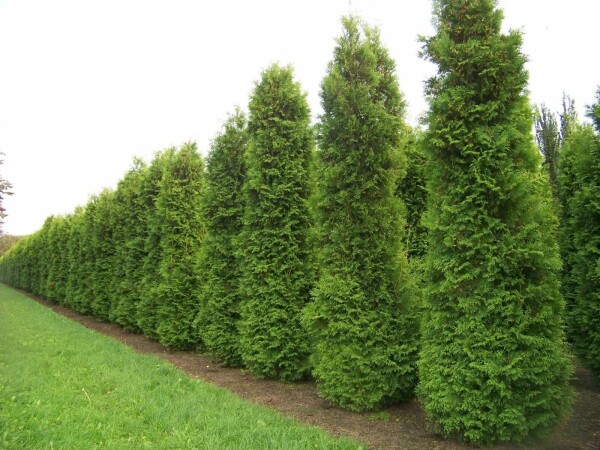


60-80

3
At Heijnen Plants, we take pride in offering the Thuja occidentalis 'Brabant', commonly known as the white cedar, a distinguished conifer that has garnered favor for its dense foliage and vibrant green hue. Esteemed for its robust nature and ease of care, this particular species does not flower but instead provides a lush, evergreen backdrop that remains constant throughout the seasons. Ideal for creating a living fence or adding structure to your garden, the Thuja 'Brabant' is a splendid choice for those looking to infuse their outdoor spaces with perpetual verdancy.
































The Thuja occidentalis 'Brabant', commonly known as white cedar, is a robust conifer that is highly prized for its hardiness and evergreen foliage. This cultivar of Thuja is well-suited for creating dense hedges that provide privacy and wind protection throughout the year. Its resilient nature and attractive greenery make it an excellent choice for both residential and commercial landscaping.
As a hedge or solitary plant, the 'Brabant' variety is a versatile addition to any garden. It maintains its vibrant green foliage across all seasons, ensuring a constant display of natural beauty.
Several features distinguish the Thuja 'Brabant' as a superior landscaping plant:
For those considering the Thuja occidentalis 'Brabant' for their landscape, the following tips will ensure optimal growth and appearance:
We would like to provide some tips on how to plant and care for a Thuja occidentalis 'Brabant'. By following these tips, you can be sure to enjoy your Thuja occidentalis 'Brabant' for a long time.
Adaptable to various light conditions, Thuja occidentalis 'Brabant' thrives in full sun, which promotes the densest foliage, but also grows well in partial shade or shade. This species is not particular about soil type; however, it flourishes best in a location where the soil is consistently {R. well-drained}. With impressive winter hardiness, it can withstand temperatures as low as -34.5°C to -40.0°C, aligning with USDA zone 3, making it suitable for a range of climates while maintaining its vibrant green hue throughout the seasons.
To plant Thuja occidentalis 'Brabant', select a site with any well-drained soil type and a location that can range from full sun to shade. Space the plants according to the desired hedge thickness, bearing in mind their fast growth rate of 30-50 cm annually. A root ball should be well moistened before planting, ensuring a seamless transition into the ground. Planting can ideally occur in the spring or autumn to optimize root establishment. Once in place, water the plants thoroughly to settle the soil around the root ball, fostering a stable environment for vigorous growth.
Thuja occidentalis 'Brabant' benefits from being pruned twice per year to maintain its dense, aesthetically pleasing shape. The first pruning should occur in early spring, before the growing season begins, and the second in late summer to early autumn. It is essential to avoid pruning when the plant is dormant in winter or during extreme heat in mid-summer. This species tolerates heavy cuts, but for optimal growth and form, it is advisable to prune lightly and regularly. Pruning also encourages the plant to develop a rich green foliage that remains vibrant through all seasons.
Ensuring that the soil around Thuja occidentalis 'Brabant' remains consistently moist, particularly after planting, is crucial for the establishment of a robust root system. While the species is drought-resistant once established, attentive irrigation during prolonged dry spells will maintain its lush, green appearance. During the initial growing years, regular watering will encourage vigorous growth, with the aim of reaching the impressive annual increase in height of 30 to 50 centimeters. After establishment, the evergreen's watering needs will decrease, but the soil should never be allowed to become completely dry.
To maintain the robust greenery and enhance the growth rate of Thuja 'Brabant', a balanced fertilization regimen is key. Apply a complete, slow-release fertilizer formulated for evergreens in early spring to kickstart the growth cycle. A second application in mid-autumn will support the plant through winter, catering to its exceptional winter hardiness. The fertilizer should be evenly distributed around the base of the hedge, taking care to avoid direct contact with the foliage or stems. This approach ensures that the plant receives a consistent supply of essential nutrients, promoting a dense, healthy hedge that remains a lush green throughout all seasons.
The Thuja occidentalis 'Brabant' is a robust conifer with a dense, conical shape that makes it ideal for privacy hedges and windbreaks. Its root ball ensures a strong foundation, allowing for successful transplantation and establishment in a variety of landscapes. This species is known for its adaptability to pruning, enabling gardeners to maintain a desired size and form with ease. Furthermore, it provides year-round interest with its evergreen foliage, adding a constant splash of green to gardens.
The Thuja occidentalis 'Brabant' is a magnificent choice for those seeking a robust, lush green presence in their landscape. This splendid conifer is revered for its dense foliage and elegant, conical shape, making it an exemplary addition to any garden seeking year-round verdancy and structure.
